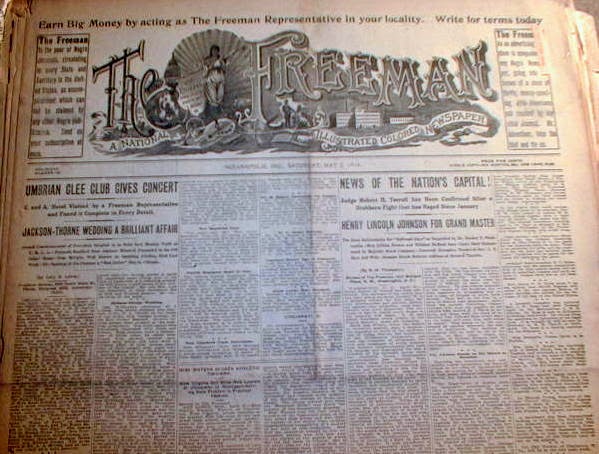Hey, cats! When did blues first appear in the paper? ‘Cats’, too, come to that?
 |
| USA’s first illustrated black paper, The Indianapolis Freeman |
print as a description for African-American music? It wasn’t until as late as 1910, would
you believe, according to the American academics, Lyn Abbott and Doug Seroff,
who discovered the term in The Indianapolis Freeman of 10 April 1910.
reviewing the ventriloquist act of a young black Memphis vaudevillian, John W.
F. ‘Johnnie’ Woods, who was touring the southern states with a review called
the Plant Juice Medicine Company. Just 22, Woods was employed as a “Buck and
back end wing dancer, female impersonator and ventriloquist”. Buck and wing
dancing was demonstrated by minstrel performers – black and white – from about
1840 onwards and later incorporated into vaudeville. You might be interested to
hear that the term “buck” for a Negro originated in the seventeenth century in
the West Indies, from the term “po-bockorau” which meant buccaneer or
 |
| Slaves in the Carolinas called poor Irish “po’ bucks” and the Irish jig subsequently became the buck dance |
troublesome
sailor. Slaves in the Carolinas shortened this to “po buck” to describe the
poor Irish immigrants who were arriving, and subsequently renamed the Irish jig the buck dance.
duties as a medicine show drag queen and buck dancer, he took to the stage as the ventriloquist,
Professor Woods, with his dummy, Henry, whom he would pretend to get drunk. It
was a review of Woods’ and Henry’s act in Jacksonville, Florida, on 10 April
1910, that the Freeman described how Woods, “uses the ‘blues’ for little Henry
in this drunken act.”
 |
| Medicine shows like this often featured musical acts |
reporting, in its edition of 16 July 1910, how a certain “Mr. Kid Love is
cleaning up with his ‘Easton Blues’ on the piano. He is a cat on the piano.”
This was 40 years before the beat-era term “cat” was supposed to have emerged in
the 1950s. Who Kid Love was, there’s now no trace, but two years later, his
chitlin’ circus contemporary, H. Franklin ‘Baby’ F. Seals, released
the first blues published by an African American and the first blues with
vocals ever published. This was “Baby Seals’ Blues” released in August 1912,
generally considered the second blues sheet music published after Hart Wand’s
“Dallas Blues” in March 1912. (For full lyrics, see my ‘Mixed Musical Duos and
First Blues Vocals Ever Published’ post of 6 Nov 2013.)

 Better still, why not invest in my “How
Better still, why not invest in my “HowBlues Evolved” books complete with hundreds of fascinating old blues photographs. (The history’s split into two volumes to accommodate all the picture files.) Invest in both volumes of “How Blues Evolved” to find out all there is to know about the evolution of blues for less than the price of a drink and a sandwich.
In the UK, get your FREE How Blues Evolved previews on this link below:
This link will get you to Amazon USA:






We have some knowledge about Kidd Love. E.g.: He was born in the 1870s and died in 1913. He was an associate of Virginia Liston, and his wife Gussie Love was also an entertainer. He performed in a piano-drums duo, which was a fad in the ’00s-’10s. As of early 1910 he, George W. Thomas, Franklin Seals, and Les Copeland were all performing near each other in Houston (with a George Williams playing drums for both Love and Seals), and as of 1909 he and Benny French were both performing in Memphis.
Extremely grateful for such fascinating information, Joseph. Thank you so much.